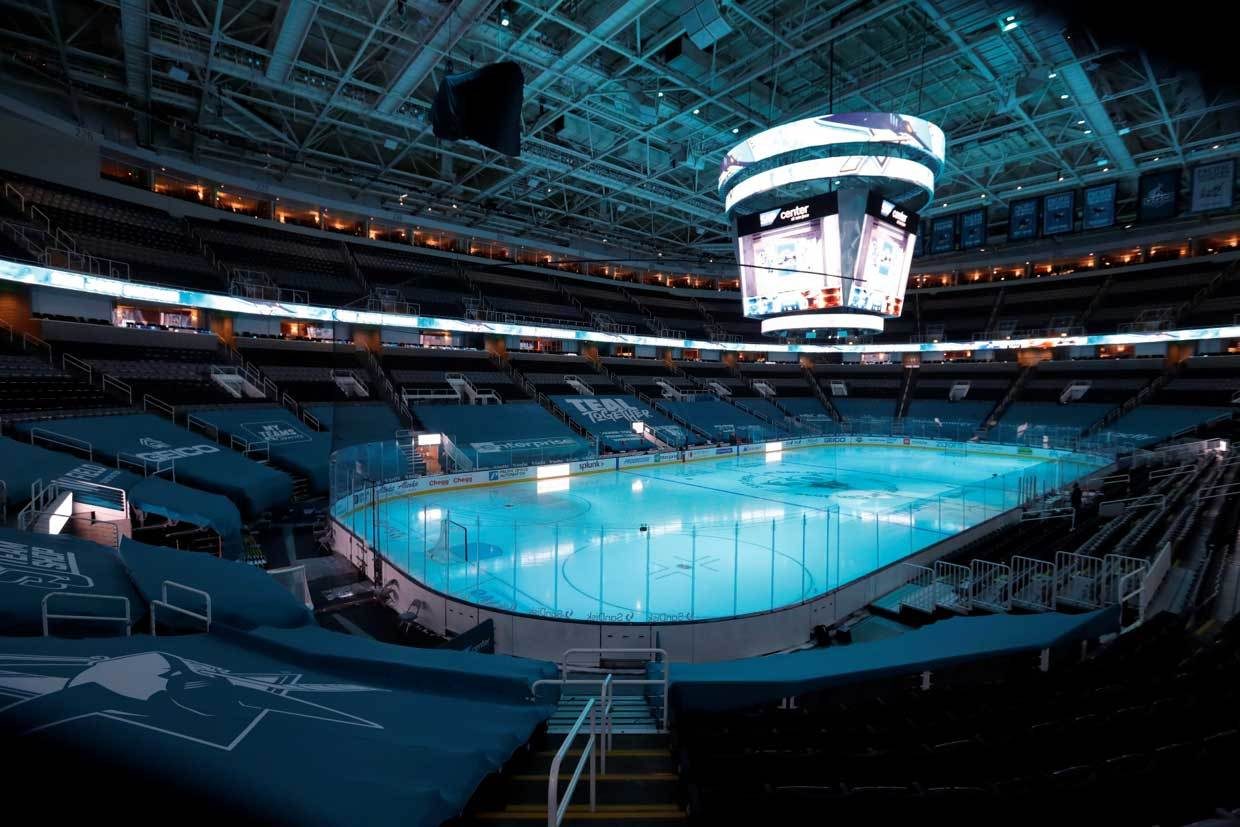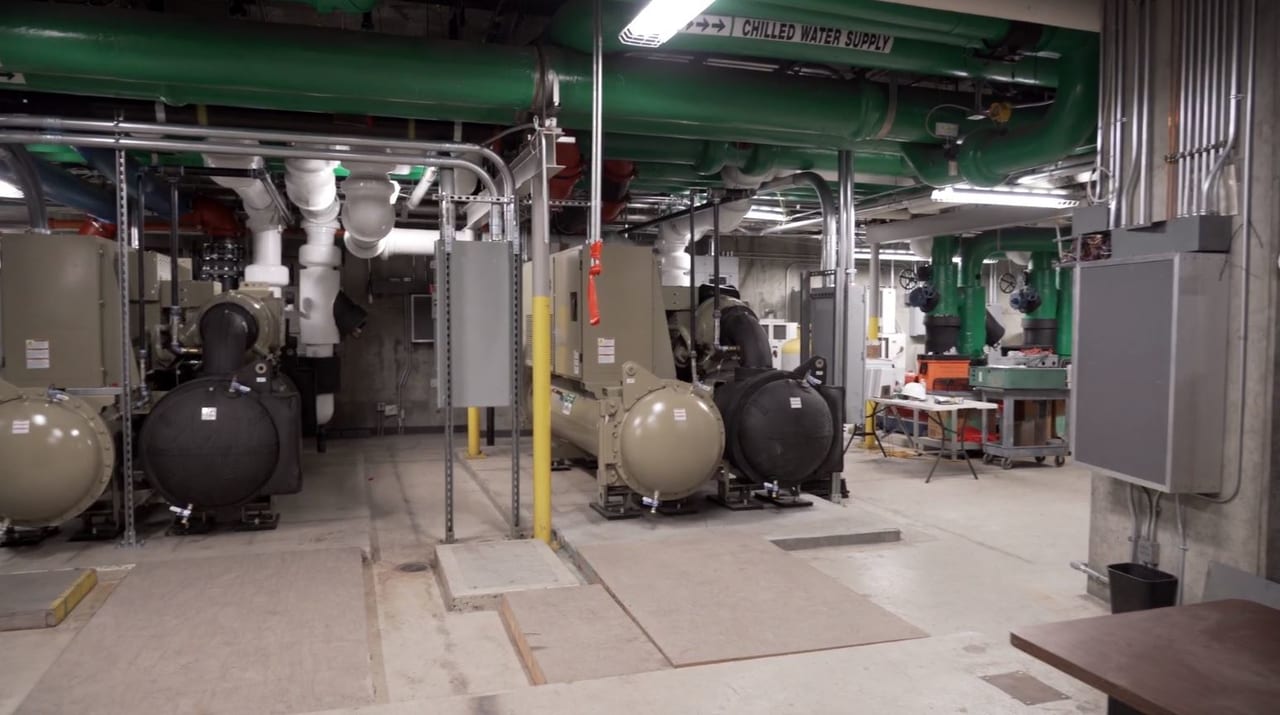
Case In Point
San Jose Sharks Score with Opteon Refrigerant
SCROLL
With factors such as environmental sustainability, equipment reliability, system performance, and safety top of mind, team administrators quickly converged on Opteon XP10 (R-513A).
FIGURE 1: California’s SAP Center, home of the San Jose Sharks®, was recently upgraded with new ice-making refrigeration systems and building air conditioning chillers.
Image courtesy of Chemours

California’s SAP Center, home of the San Jose Sharks®, was recently upgraded with new ice-making refrigeration systems and building air conditioning chillers. At the start of the project, there were a variety of refrigerant choices to consider, which led the Sharks to research all available possibilities. Throughout the process, the facility’s engineering team consulted with officials from the NHL, along with representatives from Chemours, makers of Opteon™ refrigerants, and Trane Technologies™. With factors such as environmental sustainability, equipment reliability, system performance, and safety top of mind, team administrators quickly converged on Opteon XP10 (R-513A).
Jon Gustafson, vice president, SAP Center, discussed the Sharks’ commitment to sustainability and the factors that went into their decision to upgrade to Opteon refrigerant in the Q&A below.
Allgood: When it came time to replace your existing refrigeration systems at the SAP Center, you had a number of options to choose from but ended up using Opteon refrigerant. What refrigerants and systems did you consider? What were the major criteria when making your decision?
Gustafson: Well, ice is our business, so, to start off, we researched everything. Our local jurisdiction (the city of San Jose) frowned upon ammonia (R-717) due to its relative safety risks. We were really looking for something that was very reliable and, most importantly, ecofriendly, so Opteon became the obvious choice for replacing our current refrigerant.
FIGURE 2: Two 200-ton Trane Technologies Optimus™ Helical Rotary Chillers were installed to manage the ice at the SAP Center.
Image courtesy of Trane Technologies

Allgood: This recent project involved both ice-making refrigeration and the building’s air conditioning system. How did that impact your options and decisions?
Gustafson: It all came together here. Our ownership is driving us toward ecofriendly and zero carbon across all our mechanicals, so, again, Opteon was a perfect solution for us, since it performed well at both ice-making and in building HVAC conditions. In addition to its performance in both applications, since XP10 is a class A1 (low-toxicity, nonflammable) refrigerant, all of our chillers could be located in the same machine room.
Allgood: The Sharks have completed several sustainability-focused projects at the arena. How does this refrigeration upgrade contribute to your sustainability vison and goals?
Gustafson: The Sharks organization is proud of all our initiatives to reduce the impact of our operations on the environment, including the recent upgrades of the SAP Center’s HVAC and ice-making systems. We are delighted to pioneer an environmentally friendly solution, like Opteon, as a sustainable alternative to legacy refrigerants for professional and community rinks across the country.
Allgood: California has long been at the forefront of utilizing sustainable technologies. How important was that in your view?
Gustafson: Extremely important. In northern California, where the SAP Center is located, the environment is important to our organization, fans, and communities. What we need to do now is make changes for the future; so, this was a big decision for us and the right decision at this time.
Allgood: How have the chillers performed to date and what’s been the feedback from the teams on ice quality?
Gustafson: Everything has been fantastic. To date, from installation, start up, initial ice build, and return to play, the ice quality has met or exceeded our players’ expectations. On top of that, to be able to operate our facilities efficiently, reliably, and safely is huge for us and any other similar type of facility.
Allgood: The San Jose Sharks are the second NHL club to install Opteon and are leading by example. What impact do you hope this will have on community rinks in the San Jose area and beyond?
Gustafson: As I mentioned before, we are very focused on sustainability and what we can do for the environment. Certainly, as leaders in the community, we hope others will learn from what we’ve done and follow us.
The San Jose Sharks could have chosen any refrigerant solution, but when it came time to invest in a new air conditioning system and ice-making chillers for the SAP Center, they went with Opteon XP10 refrigerant. To the Sharks’ engineering team — tasked with delivering reliable, safe, and efficient refrigeration and air conditioning within an organization dedicated to improving sustainability across all its operations — Opteon XP10 made perfect sense. The Sharks’ leadership chose to provide their players and fans with a state-of-the-art facility and set a great example for other rinks to follow.
